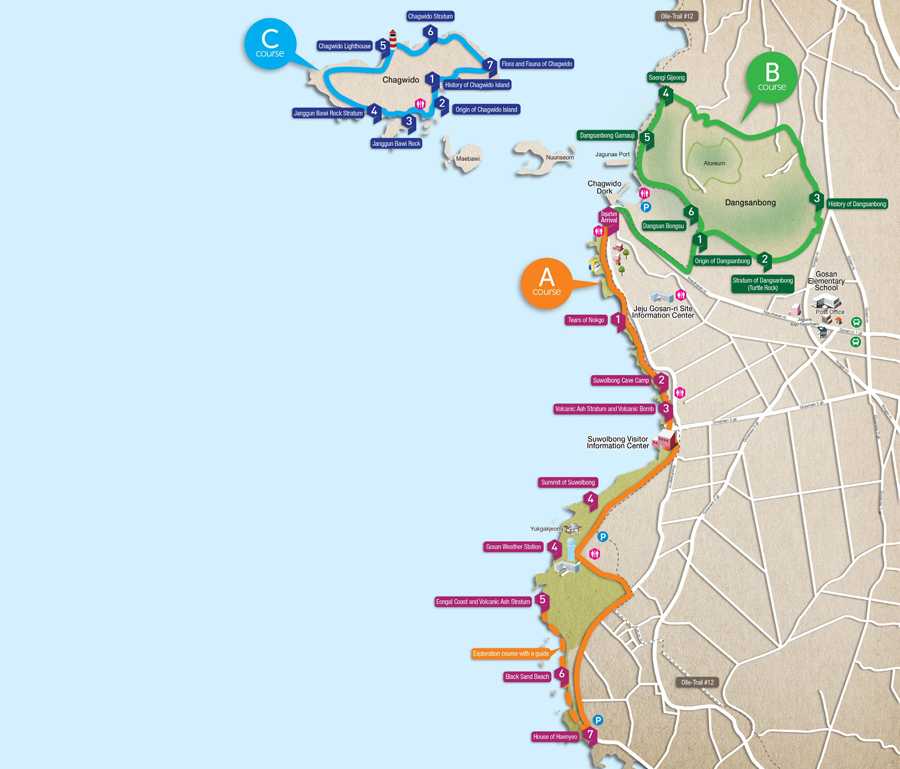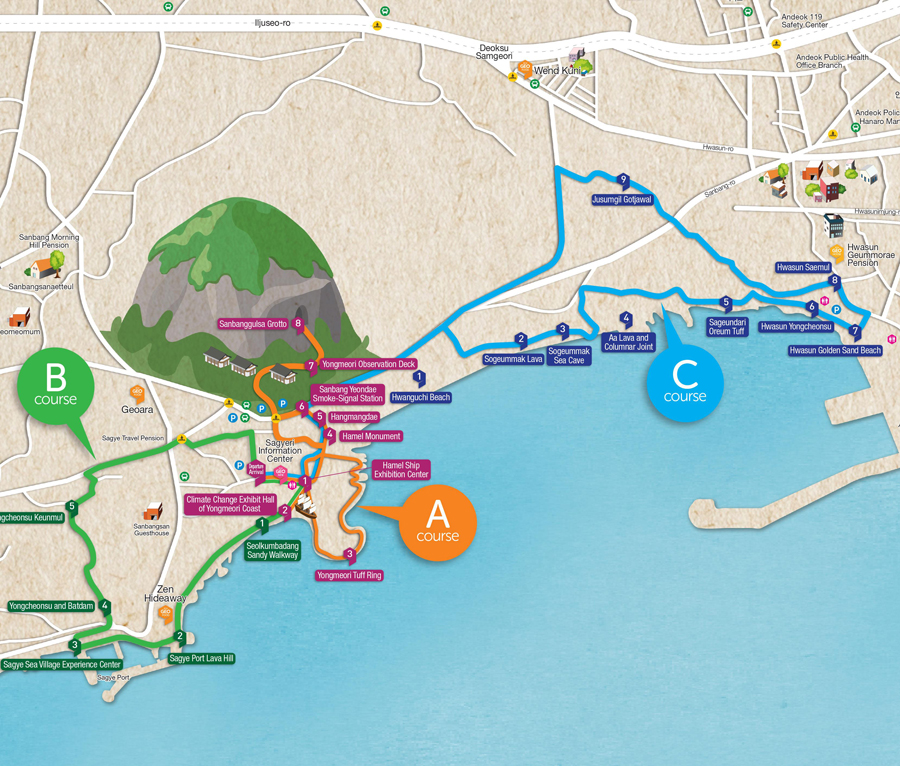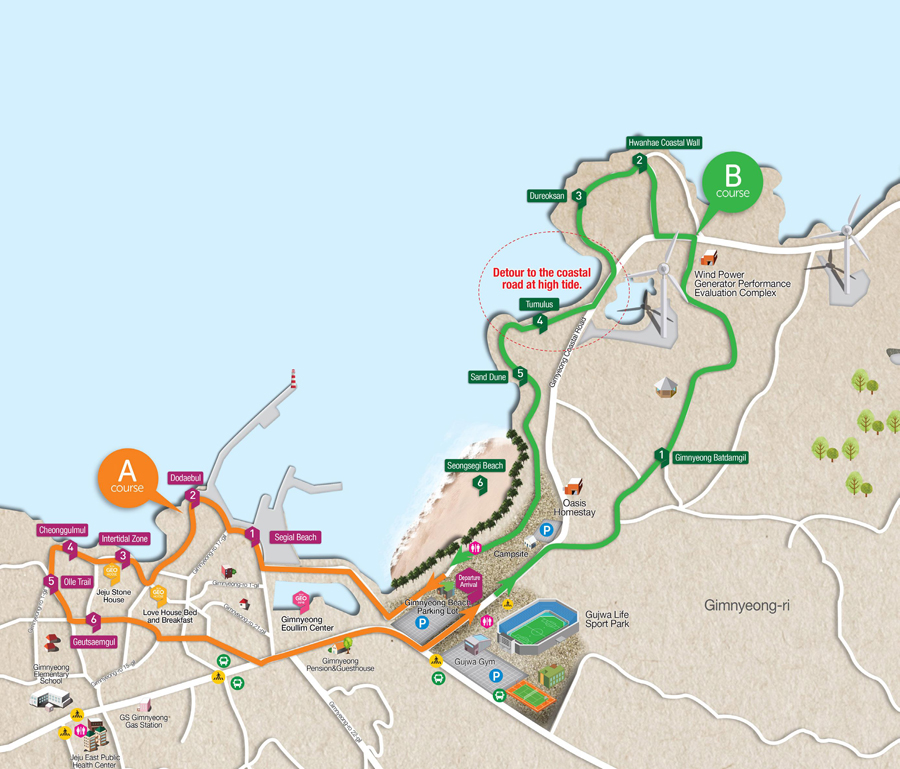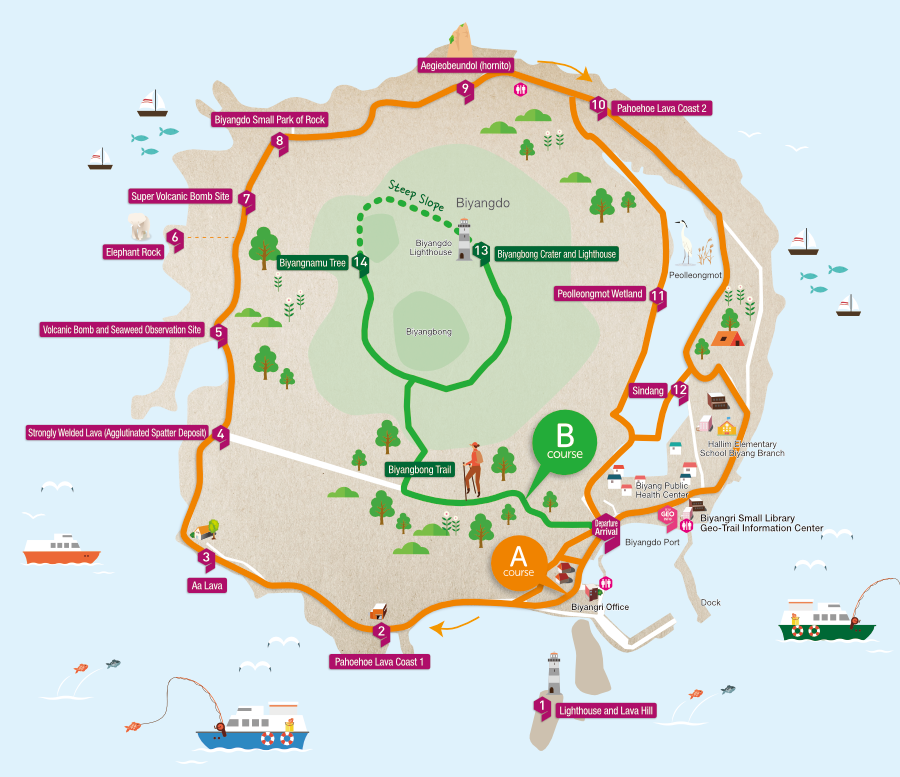FUN Geopark
December 11-17, 2021/ Jeju Island UNESCO Global Geopark,
Republic of Korea
Geotrails on Jeju island

Suwolbong Geotrail
Suwolbong is known as the textbook of volcanology with a variety of volcanic sedimentary
structures embedded in volcaniclastic deposits along the coastal cliffs.
As Suwolbong is an intersection of three Geotrail including Suwolbong Peak Geotrail, Dangsanbong
Peak Geotrail and
the Chagwido Island Geotrail each and every corner of the peak boasts unique geological resources and views.
Course A (Eongal-gil Road of Suwolbong Peak)
Tears of Nokgo → Suwolbong Cave Camp → Volcanic Ash Stratum and Volcanic Bomb → Top of Suwolbong Peak/ Gosan Weather Station
→ Eongal Coast & Volcanic Ash Stratum → Black Sand Beach → House of Haenyeo (Women Divers)
Course B (Dangsanbong Peak)
Origin of Dangsanbong Peak → Stratum of Dangsanbong Peak → History of Dangsanbong Peak → Saengi Gijeong → Dangsanbong Peak Gamauji (Cormorant) → Dangsan Bongsu (Beacon Fire Station)
Course C (Chagwido Island)
History of Chagwido Island → Origin of Chagwido Island → Janggun Bawi Rock → Janggun Bawi Rock Stratum → Chagwido Island Lighthouse → Chagwido Island Stratum → Flora and Fauna of Chagwido Island

Sanbangsan∙Yongmeori Coast Geotrail The trail contains the attractions and interesting stories of the villages (Sagye-ri, Hwasun-ri, Deoksu-ri) which surround Yongmeori Coast and Sanbangsan Mountain, features which have existed on Earth for 800,000 years. Walking down the Hyeongjehaeanro, one of Korea’s most beautiful pathways, you can enjoy Jeju's superb scenery.
Course A | 4 km (2 hours), including Yongmeori Coast / 2 km (1 hour), excepting for Yongmeori Coast Hamel Ship Exhibition Center → Climate Change Exhibit Hall of Yongmeori Coast → Yongmeori Tuff Ring → Hamel Monument → Hangmangdae (Hwangwuchi Beach) → Sanbang Yeondae Smoke Signal Station → Yongmeori Observation Deck → Sanbanggulsa Grotto
Course B | 2.5 km (1 hour) Seolkumbadang Beach Sandy Walkway → Sagye Port Lava Hill → Sagye Sea Village Experience Center → Yongcheonsu (spring water) and Batdam (stone fence) → Yongcheonsu Keunmul (spring) → Yongmeori Coast Parking Lot
Course C | 5.7 km (2 hours) Hwanguchi Beach → Sogeummak Beach Lava → Sogeummak Beach Sea Cave → Aa Lava and Columnar Joint → Sageundari Oreum Tuff → Hwasun Yongcheonsu (spring water) → Hwasun Golden Sand Beach → Hwasun Saemul (new spring) → Jusumgil Gotjawal → Yongmeori Coast Parking Lot
Inquiries Yongmeori Visitor Information Center (+82-64-792-3363)
Gimnyeong Geotrail
Mangjanggul Cave, Gimnyeonggul Cave, Yongcheondonggul Cave, and
Dangcheomuldonggul Cave in the World Natural Heritage Geomunoreum Lava Tube System exist in the underground world of the two villages.
It is not an exaggeration to say that the villages lie on volcanic lava.
There are so many geological resources–bille (broad and flat rock), pahoehoe lava,
tumuli, and coastal sand dunes–that you can even find houses standing on a cave around which a natural spring brims with water.
Course A
Gimnyeong Beach Parking Lot → Segial Beach → Dodaebul → Intertidal Zone → Cheonggulmul Spring → Olle Trail → Geutsaemgul Cave → Gimnyeong Beach Parking Lot
Course B
Gimnyeong Beach Parking Lot → Gimnyeong Batdamgil Path → Hwanhae Coastal Wall → Dureoksan Mountain → Tumulus (lava ridge) → Sand Dune → Seongse- gi Beach, Gimnyeong → Gimnyeong Beach Parking Lot
Gyorae Samdasoo Forest Path Gyorae Samdasoo Village was designated as the 13th geosite of Jeju Global Geopark in 2018. The village has geologically valuable sites, such as Gyorae Gotjawal, Gyoraeri Sediment, Jeju Stone Park, Sangumburi Crater (Natural Monument No. 263), and Mantle Xenolith Zone. From the ecological point of view, it is a habitat of rare plants (Aniseed tree, Korean dendropanax) coexisting with various creatures.
Course A (Flower Route) | About 1.2 km (30 minutes) Gyorae Welfare Center → Forest Path Entrance → Native Habitat of Hwangchilnamu (Korean dendropanax) → Habitat of Butsunnamu (Aniseed tree) → Native Habitat of Korean mountain magnolia → Forest Path Entrance → Gyoraeri Small Park
Course B (Teuri or Shepherd Route) | 5.2 km (3 hours) Gyorae Welfare Center → Forest Path Entrance → Native Habitat of Korean mountain magnolia → Habitat of Butsunnamu(Aniseed tree) → Native Habitat of Hwangchilnamu (Korean dendropanax) → Aa Lava Section → Jejujoritdae(Broad-leaf bamboo) Path → Cedar Plantation → Forest Path Entrance → Gyoraeri Small Park
Course C (Sanongbachi or Hunter Route) | About 8.2 km (4 hours) Gyorae Welfare Center → Forest Path Entrance → Native Habitat of Korean mountain magnolia → Habitat of Butsunnamu (Aniseed tree) → Native Habitat of Hwangchilnamu (Korean dendropanax) → Aa lava Section → Jejujoritdae (Broad-leaf bamboo) Path → Jatdam (stone wall) → Norinmul (a kind of spring water) → Habitat of Great Tit → Cedar Plantation → Forest Path Entrance → Gyoraeri Small Park
Inquiries Gyoraeri Village Office (+82-64-782-1746)
Dongbaekdongsan (Camellia Hill) Geotrail Located in Seonheul-ri, Jocheon-eup, Jeju City, it is a large natural camellia forest designated as Jeju Special Self-Governing Province Natural Monument No. 10. Besides old camellia trees, a variety of plants grow here with evergreen broad-leaf trees, adding academic value to the forest. Among the wetlands protected here, Meonmulkak is registered as a Ramsar site. This unique forest will present visitors an unforgettable memories of the green nature of Jeju.
Course A (Seonheulgot Dongbaekdongsan Forest Route)
Dongbaekdongsan Wetland Center → Doteulgul Cave → Dongbaekdongsan (Sangdoreondeok → Meonmulkkak) → Forest Letter Box → Pojedangil → Dongbaekdongsan Visitor Information Center
Course B (Jeju 4.3 and Peace Route)
Naksundong 4·3 Castle Site Bus Stop → Hamdeok Elementary School Seonheul Branch
→ Dongbaekdongsan (Meonmulkkak → Sangdoreondeok Hill) → Doteulgul Cave → Dongbaekdongsan Visitor Information Center → Utgareum Bus Stop
Course C (Village and Forest Coexistence Route)
Seonheulri Office Bus Stop → Reuse Workshop Hamkkeganeungil (Going Together) → Path into the Village
→ Hamdeok Elementary School Seonheul Branch → Dongbaekdongsan (Meonmulkkak → Sangdoreondeok Hill)
→ Doteulgul Cave → Dongbaekdongsan Visitor Information Center → Seonheulri Office

Biyangdo Geotrail
Biyangdo is an island about 5 km from Hallim Port. The name means an island that came flying from the sky.
The island still has
two cinder cones in the island's central Biyangbong Peak area, and the remains in the north- west coast tell that there was
another one long time ago.
Course A
Biyangdo Port → Lighthouse and Lava Hill → Pahoehoe Lava Coast 1 → Aa Lava → Strongly Welded Lava (Agglutinated Spatter Deposit)
→ Volcanic Bomb and Seaweed Observation Site → Elephant Rock → Super Volcanic Bomb Site → Biyangdo Small Park of Rock → Aegieobeundol (hornito) → Pahoehoe Lava Coast 2 → Peolleong- mot Wetland → Pojedan (altar) → Biyangdo Port
Course B
Biyangdo Port → Biyangbong Crater and Lighthouse → Biyangnamu Tree (Oreocnide) → Biyangdo Port